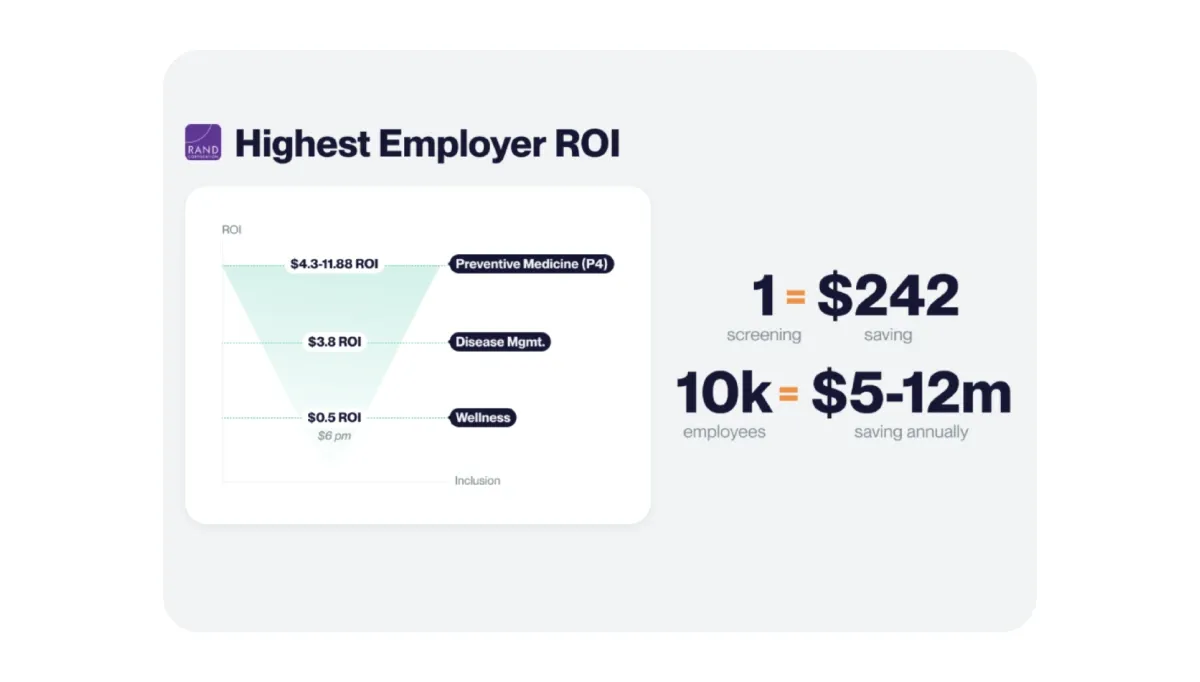Do Wellness Programs Reduce Healthcare Costs and Save Employers Money? Here's What the Data Really Shows
Did you know? Health insurance premiums for employer-sponsored plans rose by 6–7% from 2023 to 2024. The sharp increase is due to a surge in chronic illnesses, smoking-related conditions, and mental health struggles. As healthcare costs continue to surge, employers are feeling the strain more than ever.
With the rising cost of healthcare, it's no wonder that businesses are seeking practical solutions to address this issue. But what if there was a way to reduce these skyrocketing costs while simultaneously boosting employee well-being?
This is where wellness programs come into play - a solution that's been quietly revolutionizing workplace health for quite some time now. And to answer the question of the hour here, "Do wellness programs reduce healthcare costs?," keep reading.
In this blog, you will find out how wise investments in wellness can help you pave a path to lower healthcare costs and build a profitable business.
Why Are Healthcare Costs Rising and They Should Be Controlled?
In current times, 60% of United States adults have at least one chronic condition, and 40% have multiple comorbidities. This contributes to 90% of the nation's $4.5 trillion annual healthcare expenditures. Such a massive expense only threatens the company's profit margin, workforce stability, and long-term business goals.
With healthcare costs projected to rise 8–9% annually through 2025, employers must pick one of the following two strategies:
- revolutionize benefit design
- risk systemic collapse of the private coverage model
Healthcare costs are expected to continue climbing unless preventive strategies are implemented. This means that employers who treat workforce health not as a cost but as an asset will thrive.
The Evidence: Do Wellness Programs Actually Cut Healthcare Costs?
What the Research Shows (ROI and Savings)
-
According to a Harvard University study of 100 peer-reviewed journal articles, "Workplace Wellness Programs Can Generate Savings," a properly designed wellness program has the power to yield an ROI of 3.27:1 on healthcare cost reductions and another 2.73:1 on absence and related costs after approximately three years.
-
A study of PepsiCo's wellness program data over seven years suggests that the company's efforts to help employees manage chronic illnesses resulted in $3.78 in healthcare cost savings for every $1 invested.
This data shows that wellness programs can significantly lower healthcare costs for businesses, making them a wise long-term investment.
Related read: 9 Healthcare Cost Reduction Strategies For Employers To Try
RAND suggests that a wellness program may take at least 5 years to work effectively and become cost-neutral. Workplace wellness programs may not always reduce healthcare costs. If employers help employees who already have chronic diseases, they are more likely to see a good return on their investment.
Where the Savings Come From
There are three fruitful strategies to reduce healthcare costs. Let’s dive in and explore these cost-saving approaches.

1. Preventive measures
Chronic illnesses in the workplace are on the rise. Chronic diseases are reducing productivity, increasing absenteeism, and driving up healthcare costs. They are also driving up operational expenses.
For this very reason, wellness programs can serve as a great strategy to reduce large expenses. Comprehensive preventive care programs reduce long-term expenses by addressing health risks before they occur. So, how do wellness programs help? Here's what they include:
- Step challenge and other activity challenges
- Health screenings (for blood pressure, cholesterol, diabetes, cancer, etc.)
- Smoking cessation initiatives
- Stress management and mental health support
- Preventive health education and risk assessments
The above components directly align with the objective of preventive healthcare. Fix unhealthy behaviors, promote healthier ones, and identify health risk factors early.
Here is an instance of how preventive measures can help reduce healthcare costs.
Employees in wellness programs undergo 28% more preventive screenings, allowing them to catch conditions early. This means if they undergo any treatment, it will cost 68% less than the usual cost. For example, biometric screenings reduce diabetes progression costs by $4,346 per case.
2. Chronic disease management
Investing in chronic disease management has a fair chance of delivering positive healthcare cost reduction.
Here are some case studies that will shed some light in this regard:
-
Teladoc Health's diabetes management program generated a 4.6x return on investment (ROI) after three years by reducing hospital admissions by 29% for one of its clients.
-
Hello Heart's digital cardiovascular program estimated savings of $1,434 per participant per year in medical costs.
Based on the data, it is clear that incorporating wellness programs targeting chronic diseases has a positive outcome. Now, let's move on to the final strategy that can help save employers a significant amount of money.
3. Behavioral modifications
Behavioral modification is more of a hit-and-trial strategy in terms of cutting healthcare costs. Some sources suggest altering behavior is a long shot, and expecting to reduce healthcare costs is like chasing a goose.
There are case studies that suggest wellness programs encourage physical activity, weight management, and smoking cessation, leading to a reduction in healthcare claims. Johnson & Johnson's Live for Life program is a notable example in this case.
Nuances And Limitations In The Evidence
While wellness programs offer significant benefits, it's also important to consider their limitations and challenges.
1. Short-term savings maybe modest
A study published in The American Journal of Health Promotion found that while wellness programs contributed to improved employee health behavior, healthcare cost reductions were not significant in the short run.
2. Participation rate affects the outcome
The healthcare cost returns are directly dependent on the participation and engagement rate. For instance, if the participation rate is low, the impact on healthcare costs will be minimal.
3. Wellness programs may attract already healthy employees
Wellness programs often appeal to participants who are already fitness enthusiasts. The real struggle lies in convincing the ones who need the program. As a result, the entire purpose of introducing such an initiative will not be served.
Real-World Examples: How Companies Are Saving Money with Wellness Programs
| Company | Problem | Solution | Outcome/Savings |
|---|---|---|---|
| Johnson & Johnson | Rising healthcare costs | Comprehensive wellness & risk reduction | $225 saved per employee/year; $9–10M annual savings; ROI up to 3.92:1 |
| PepsiCo | High chronic disease costs | Disease & lifestyle management | 20% cost reduction; $136 saved per member/month |
| Walmart | High utilization & hospital costs | Virtual care, wellness incentives | 11% reduction in healthcare costs; 38% drop in hospitalizations |
Johnson & Johnson

Johnson & Johnson's wellness program has set a jaw-dropping benchmark in terms of employee wellness. They focused on comprehensive wellness programs and risk reduction. And here's what they witnessed with their initiative:
According to an HBR article, Johnson & Johnson estimates that wellness programs saved the corporation $250 million in healthcare costs from 2002 to 2008. The company saw a return of $2.71 for every dollar spent.
PepsiCo:

Rand conducted a study to evaluate PepsiCo's wellness program, Healthy Living. Their goal was to analyze the impact of the two components of the wellness program: lifestyle and disease management, on healthcare costs.
The study suggests that after seven years with the program, the company achieved a healthcare cost reduction of $30 per member per month. The study highlights that the company saw significant change, particularly through disease management.
Walmart:

Walmart addressed high utilization and hospital expenses by offering virtual care and wellness incentives. A report suggests that a wellness program led to an 11% decrease in total healthcare costs among participants. Additionally, they saw a 38% reduction in inpatient hospital costs.
How To Calculate The ROI Of Wellness Programs For Your Company?
Calculating the ROI of a wellness program for your company involves calculating the benefits gained from the initiative. Here's the formula you can use to determine your benefits.
Benefits Gained = Healthcare Cost Savings + Absenteeism Savings + productivity Gains + Turnover Costs Savings.
Once you get the number, use this formula to find out the ROI:
[(Total Benefits - Program Cost) / Program Cost] × 100
Final Thoughts: Are Wellness Programs Worth the Investment?
Wellness programs can reduce healthcare costs if they prioritize the following:
-
preventive measures
-
chronic disease management
-
lifestyle changes
The data suggests wellness programs are worth investing in. However, the program must attract a sufficient number of participants and operate for at least 3 to 5 years.
Reducing healthcare costs through wellness programs is not only achievable but can lead to significant long-term savings for employers. However, the number may vary from organization to organization. The results rest upon strategic alignment between:
- program design
- financial planning
- organizational culture
Sounds like lots of work? No worries, Vantage Fit is here to do the heavy lifting for you. Vantage Fit is a rising employee wellness platform equipped to curate the right wellness program for your workforce. Talk to our experts here to learn more details and achieve the ROI you wish to have.
In short, wellness programs, when planned right, can help control healthcare costs. The data speaks for itself, and this is your sign to invest.
Frequently Asked Questions
1. What is the ROI of wellness programs?
ROI is the financial return from cost savings, productivity improvements, and reduced absenteeism, compared to the program's total cost.
2. How to reduce health insurance costs?
You can reduce insurance costs by focusing on preventive care, managing chronic diseases, and promoting long-term wellness.
3. Why are we not able to control the costs of healthcare?
Chronic conditions, unhealthy lifestyles, and rising treatment costs are the main reasons behind the rising costs.
4. What are the benefits of wellness programs?
Improved health, lower absenteeism, better morale, and reduced insurance claims.
5. Are wellness programs effective for small businesses or just large corporations?
Yes, scalable wellness platforms can be tailored to suit businesses of all sizes, including small to medium-sized businesses (SMBs).



